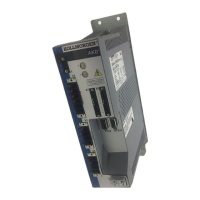7.11.2.6 Functional Description
Two different ways to apply target positions to a drive are supported by this device profile.
Set of setpoints:
After reaching the target_position, the drive device immediately processes the next target position, which results
in a move where the velocity of the drive normally is not reduced to zero after achieving a setpoint. With AKD,
this is only possible if trapezoidal ramps are used.
Single setpoints:
After reaching the target_position, the drive device signals this status to a host computer and then receives a
new setpoint. After reaching a target_position, the velocity is normally reduced to zero before starting a move to
the next setpoint.
The two modes are controlled by the timing of the bits for new_setpoint and change_set_immediately in the con-
trol word, and setpoint_acknowledge in the status word. These bits allow the setting up of a request-response
mechanism in order to prepare a set of setpoints while another set is still being processed in the drive unit. This
minimizes reaction times within a control program on a host computer.
The figures show the difference between the set_of_setpoints mode and the single setpoint mode. The initial
status of the bit change_set_immediately in the control word determines which mode is used. To keep these
examples simple, only trapezoidal moves are used.
If the bit change_set_immediately is "0” a single setpoint is expected by the drive (1). After data is applied to the
drive, a host signals that the data is valid by changing the bit new_setpoint to "1" in the control word (2). The drive
responds with setpoint_acknowledge set to "1" in the status word (3) after it has recognized and buffered the new
valid data. Now the host can release new_setpoint (4) and subsequently the drive will signal through setpoint_
acknowledge = "0" its ability to accept new data again (5).
AKD CANopen | 7 CANopen Drive Profile
Kollmorgen™ | November 2012 117

